LisbonLisboaPortugal.com
The best independent guide to Central Portugal
LisbonLisboaPortugal.com
The best independent guide to Central Portugal
Evora, Portugal: an independent travel guide for 2025
Évora is the magnificent museum-city of the Alentejo, a place where 2,000 years of Portuguese history are etched into the walls of its beautifully preserved centre. As the region's capital and a UNESCO World Heritage site, it holds a treasure trove of monuments surpassed only by Lisbon.
Its beautifully preserved historic centre is a delightful maze of cobbled streets and sun-drenched plazas, where magnificent monuments chart its rise as a Roman outpost and medieval power. At every turn, Évora’s extensive history is evident, from the elegant Corinthian columns of its Roman Temple and the formidable towers of its Gothic cathedral to the chilling, macabre beauty of the Capela dos Ossos (Chapel of Bones).
Yet, Évora is no sleepy museum city. It is vibrant and full of life, energised by the students of its historic university, one of the oldest in the world.
Beyond the walls, Évora is the gateway to the Alentejo, a region of rolling, sun-baked plains, ancient cork forests, and fortified whitewashed villages. With its deep-rooted traditions and an unhurried pace of life, this is a corner of Portugal with a distinct character all its own.
This guide will provide everything you need to discover Évora and the wider Alentejo, helping you plan the perfect visit to one of Portugal's most historic and fascinating destinations.
Highlights of Evora
There are many outstanding tourist sights in Evora, and the best are:
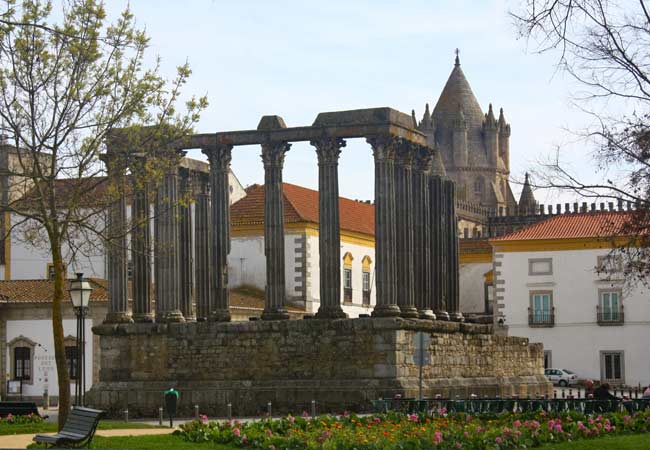
The Templo Romano Évora – Constructed in the first century as a temple dedicated to the cult of Augustus, it is the best-preserved Roman Temple on the Iberian Peninsula.
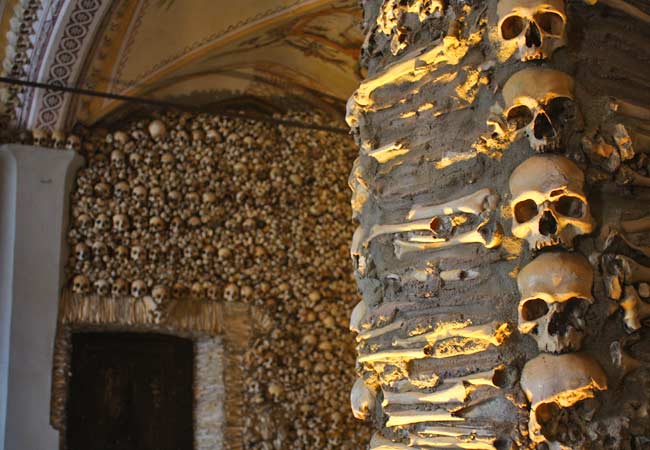
The Capela dos Ossos – A macabre chapel lined with the bones of over 5,000 bodies that were exhumed from the city's medieval graves. Ghoulish, but still the most popular tourist attraction in Evora... more information
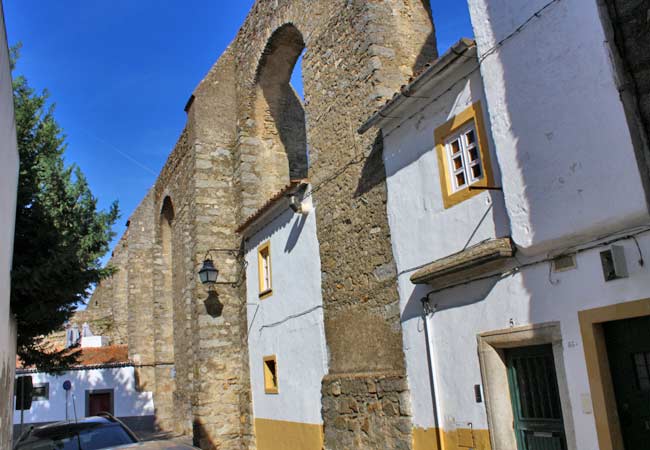
The Aqueduto da Água de Prata – The 16th century aqueduct that once transported water from over 9 km away to Evora. Outside of the city walls, the aqueduct rises alone on the grand aches, while within the city walls, houses and shops have been constructed beneath the stone arches.
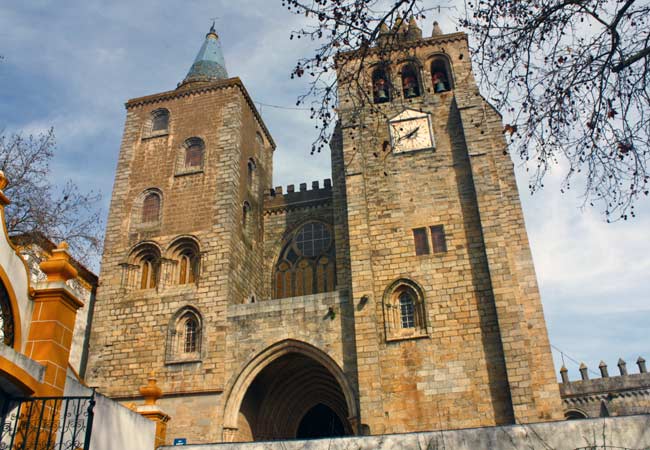
The Catedral de Évora – This mighty 13th-century cathedral is regarded as the finest gothic building in Portugal and signifies Evora's medieval importance.
Related articles: The best sights of Evora
1-day trip to Evora - Evora as a day trip
Evora is a must-see day trip destination when staying in Lisbon. However, it will take up an entire day as there is a lot of travel involved, especially if you are reliant on public transport. Once in Evora, all of the major tourist sites can be visited within about 4-5 hours of sightseeing.
A typical 1-day tour of Evora is shown in the interactive map below. The green route is the classic tour of the historic centre, which includes the cathedral, the Roman Temple, the university, and the Bone Chapel. The yellow route is an additional tour covering the north of the city, which follows the aqueduct. The two grey lines are the routes to and from the train and bus stations.
Tour sights; 1) Praça do Giraldo 2) Igreja de Santo Antão 3) Catedral de Évora 4) Evora museum 5) Roman Temple 6) Evora university 7) Igreja do Carmo 8) Igreja da Graça 9) Igreja de São Francisco 10) Capela dos Ossos (bone Chapel) 11) Ruínas Fingidas 12) Palácio de Dom Manuel (Royal Palace) 13) Câmara Municipal (city hall) 14) Arco Romano 15) Beginning of the aqueduct 16) Arches of the aqueduct
Warning: Many of the tourist attractions are managed by the city council and shut for a two-hour lunch.
Advice: During the summer, Evora is significantly hotter than Lisbon, and the intense sun makes sightseeing very draining from 11-3pm.
Related articles: A day trip to Evora
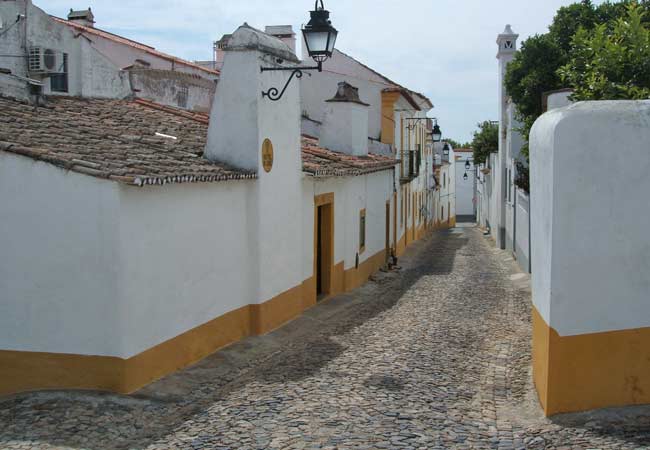
The pretty cobble backstreets in Evora
A longer stay or holiday in Evora
If you have the time, Evora is the ideal place to slow down the pace of travel and experience authentic Portugal. The surrounding region is also offers rural tours, yoga retreats and the chance to truly unwind.
Spending at least one night in Evora allows visitors to discover the city at a relaxed pace and is highly recommended in the hot summer months. For those staying two nights, a third day can be spent visiting the pre-historic standing stones of Cromeleque dos Almendres and the majestic castle at Evoramonte.
Advice: To get the most of the Alentejo region a rental car is a must as there are limited public transport services.
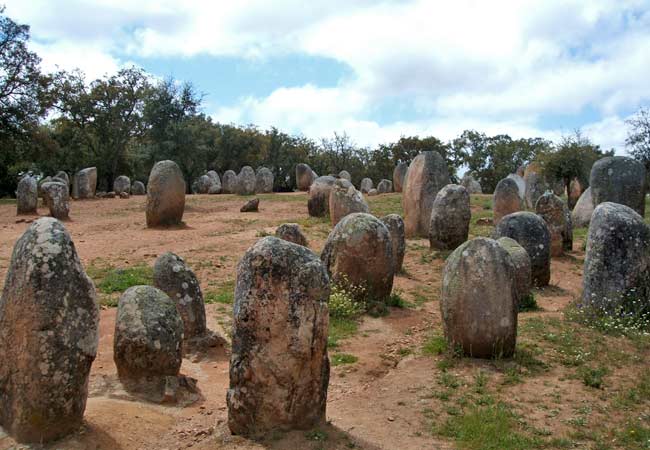
The Cromeleque dos Almendres date from 6000 to 4000bc, and certain stones have ancient circular engravings
A longer stay in Evora will allow much more exploration of the Alentejo region, including day trips to marble towns of Estremoz, Vila Viçosa and Borba, and the fortified town of Elvas. Elvas has unique star-shaped defences and forts, which were constructed from centuries of border fighting against Spain, and is a fascinating tourist destination.
Related articles: Guide to Elvas
Evora has the added benefit of providing great value for accommodation and food, with prices significantly cheaper than Lisbon or the Algarve.
The map below shows the location of hotels and rental rooms in Evora, and by altering the date to your holiday, the map will display current prices:
Booking.com
Evoramonte castle stands atop one of the highest hills of the Alentejo region
Travel from Lisbon to Evora
Evora is connected to Lisbon by regular and inexpensive rail and bus services. There are more daily bus departures than the train, but the railway provides a more relaxing journey.
Travel times for both bus and train are approximately 1.5 hours, and the fares are comparable at €13 for a one-way adult ticket. The frequency of the public transport means that Evora can be visited as a day trip Lisbon.
Related articles: Lisbon to Evora
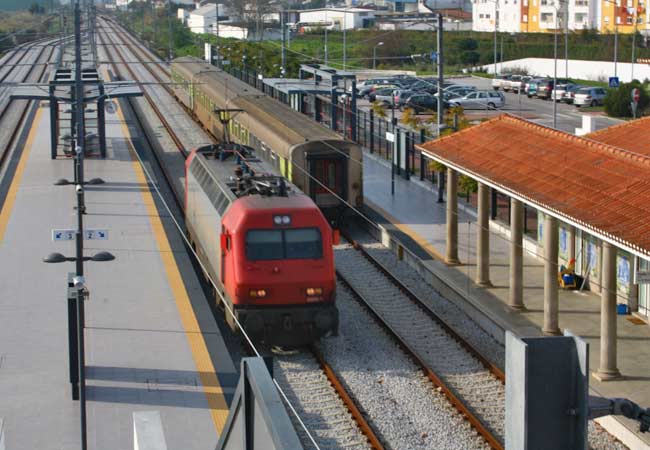
Evora train station is modern but very quiet, with only a handful of departures per day
Where to Eat in Evora
Dining in Evora is an essential part of the Alentejo experience, with options ranging from timeless institutions to innovative modern kitchens. For a legendary culinary pilgrimage, seek out the tiny, eight-seat counter at Botequim da Mouraria, or immerse yourself in the multi-course, no-menu feast at Taberna Típica Quarta-feira. For a more formal taste of history, Restaurante Fialho has been a bastion of classic Alentejo dining for generations.
The new guard is brilliantly represented by the refined farm-to-table concept at Origens and the creative Portuguese tapas at Dona Laura, which is perfect for a more social meal. For heartfelt, high-quality family cooking in a cozy setting, Vinho e Noz is a consistently top-rated choice. If you’re seeking an authentic and affordable neighborhood meal beloved by locals, look no further than Taska Fina.
Many of Evora’s most memorable restaurants are small, family-run establishments where demand is high. For more details, see our complete guide on where to eat in Evora.
Best Tourist attractions of Evora (in detail)
There are three must-see historical monuments in Evora; they are the Sé Cathedral, the Roman Templo de Diana and the Aqueduto de Água de Prata. Most visitors to Evora will also want to see the Bone Chapel.
The Templo de Diana
The Templo de Diana is the best-preserved Roman temple on the Iberian Peninsula. The temple is named after the Roman goddess Diana but when it was constructed in the 1st century, it was actually dedicated to Augustus – the emperor who created a cult about himself.
The temple has been so well preserved, as during the medieval era it was incorporated into the palace that stood here. Later, after the destruction of the palace, the temple was used as an abattoir and even a wood store!

The Templo de Diana with the cathedral to the rear
The Capela dos Ossos (Bone Chapel)
There is no stranger tourist attraction in Evora (and possibly central Portugal) than the macabre Capela dos Ossos. The walls of this small chapel are lined with the bones and skulls of more than 5,000 bodies that were exhumed from the crowded graveyards of Evora.
These bones have not just been stored in the walls, but indeed create the decoration of the chapel. The Franciscan monks who designed the chapel followed the Counter-Reformation belief, that death is purely a transitory stage.
The creepiness is compounded by the wording above the entrance, which reads "We the bones wait for yours".
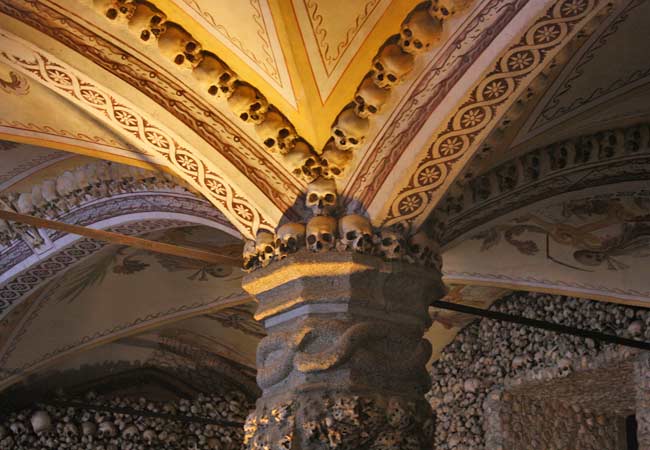
Skulls and bones form decorations
The Aqueduto de Agua de Prata
The Aqueduto de Agua de Prata provided a constant supply of water to the city and is connected to the water springs in Graça do Divor, 18km to the north. The aqueduct was commanded by King João III and was completed in 1537.
The highest arches are seen outside of the city walls, while inside the city, houses and shops have been constructed beneath the arches.
Historic intrigue: The name of the aqueduct (the Silver Water Aqueduct) has a double meaning. The first, and more obvious, is the silver appearance of the water under the bright summer sun. The second reflects the astronomical construction costs, which were so high that it nearly bankrupted the regional government.
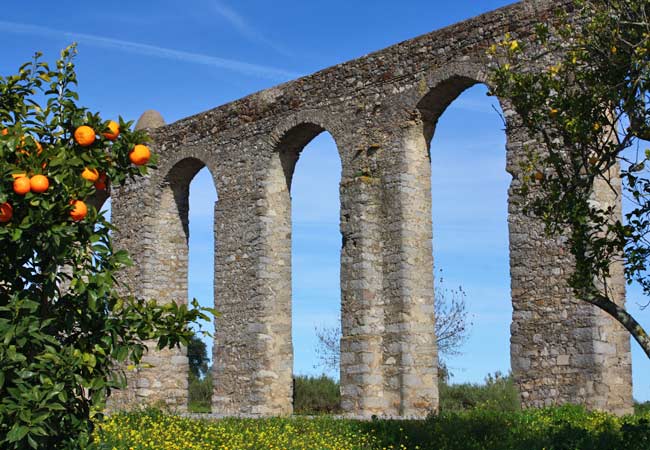
The huge arches of the aqueduct span the valley outside of the city walls
The Sé cathedral
The Sé cathedral is a beautiful example of Gothic architecture.
The cathedral has two mismatched towers, and this is unique for gothic religious buildings, which usually have a panel of symmetry across the front portal.
A visit to the cathedral allows access to the roof, from which there are wonderful views over Evora.
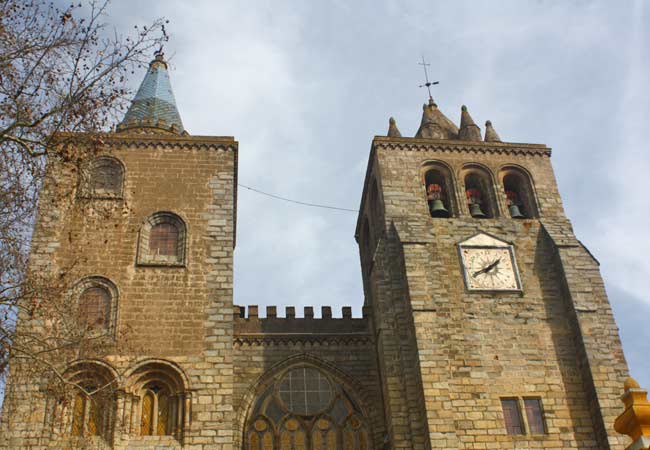
The cathedral with its two very different towers
When best to visit Evora?
Evora is incredibly hot in the summer warm in both spring and autumn: Winters are mild but there is always the chance of wet days.
Early spring is the best season to visit Evora, when the rolling plains are lush and full of flowers and the days are pleasant temperatures for sightseeing on foot.
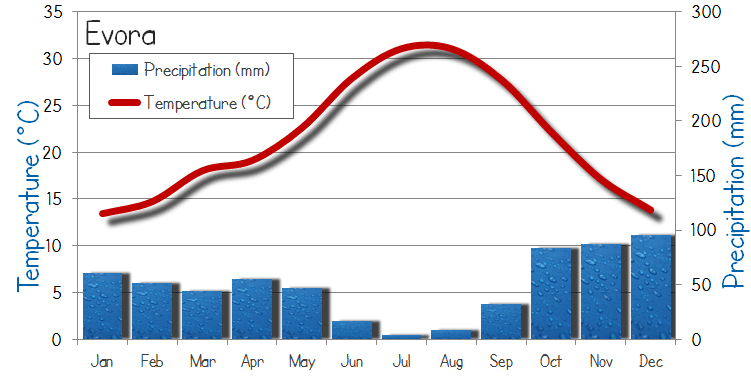
The average weather of Evora
Summers are extremely hot in the Alentejo region and sightseeing can only be done in the early morning or late in the afternoon. For tourists intending on visiting during the summer, follow the locals’ example, by taking a much slower pace and enjoying a long lunch. All municipal tourist attractions close for an extended two-hour lunch, irrespective of the season, so plan your day of sightseeing around this long break.
If you've found our content valuable, we'd welcome your support.
The digital publishing landscape has evolved significantly. As a small independent publisher, we face growing challenges. Search engines increasingly favour paid content over organic results, while AI-generated content often reproduces original work without attribution.
To support our work, please consider bookmarking this page (press Ctrl + D) for quick access. If you find an article helpful, we'd be grateful if you'd share it with friends on social media.
For specific questions, please see our Reddit community at r/LisbonPortugalTravel.
Should you notice any outdated or incorrect information, please contact us at [email protected]
Thank you for helping us continue to provide valuable content in an increasingly challenging digital environment.


























